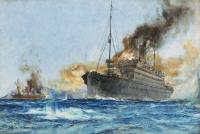 On September 14th, 1914, one hundred years ago today, off the Brazilian island of Trindale, one of the stranger naval battles of World War I was fought between two converted passenger liners, one of which was disguised to look like the other. In a battle of doppelgängers, the German liner lost to the British ship that it resembled.
On September 14th, 1914, one hundred years ago today, off the Brazilian island of Trindale, one of the stranger naval battles of World War I was fought between two converted passenger liners, one of which was disguised to look like the other. In a battle of doppelgängers, the German liner lost to the British ship that it resembled.
Cap Trafalger was a passenger liner built for the Hamburg-South America Line for their service between Germany and the River Plate. She was 613 feet long with a beam of 72 feet, 18,710 GRT and could carry nearly 1,600 passengers. She went into service in April of 1914, but by August, with the outbreak of war, she was requisitioned by the German Imperial Navy as an auxiliary cruiser. Cap Trafalger rendezvoused at the remote Brazilian island of Trindade, 500 miles east of the Brazilian mainland, with the gunboat SMS Eber, which transferred naval officers, ammunition and armaments to the liner. Two 4.1 inch guns and six one-pounder pom-poms were installed on the ship. All were manned by German naval personnel. The ship was given the mission to act as a commerce raider, sinking British merchant shipping.
Cap Trafalger had been built with three stacks, one of which was a dummy stack. When guns were installed on the ship, they also removed the third stack to help disguise the appearance of the ship. With two stacks, Cap Trafalger looked in profile quite similar to the British Cunard passenger liner, RMS Carmania, a two stack ship with roughly the same length and breadth. Cap Trafalger set off on a cruise in search of British merchant vessels but failed to locate any and in September returned to the rendezvous point off Trindade island to refill its bunkers.
RMS Carmania was a Cunard Line passenger liner built in 1905. At the beginning of the war, she was converted into an armed merchant cruiser with the addition of eight 4.7 inch guns. On September 14th, RMS Carmania spotted smoke from Cap Trafalger.
The two passenger liners, which happened to look very similar to each other, began a two hour gunnery duel. Despite having fewer and lighter guns, at first, the German ship appeared to have the advantage. The Carmania was hit 73 times. Her bridge was completely destroyed, she was on fire and she had taken five hits on the waterline. Cap Trafalger, however, was also on fire. A shell which hit below the waterline had ruptured several compartments and the ship was sinking. The colliers, which had been refueling Cap Trafalger, rescued 279 German sailors. Between 16 and 51 Germans died in the battle. The British lost 9 sailors.
Cap Trafalger had the unfortunate distinction of having failed to sink any British merchant vessels in her short career. She was perhaps the only converted passenger liner ever sunk in battle by her doppelgänger. Thanks to Frank Hanavan for pointing out the anniversary of the battle.
